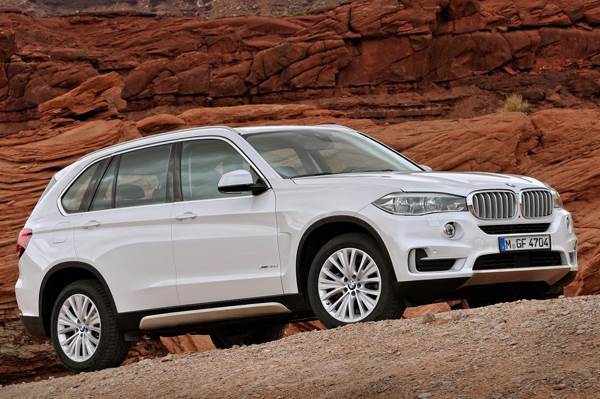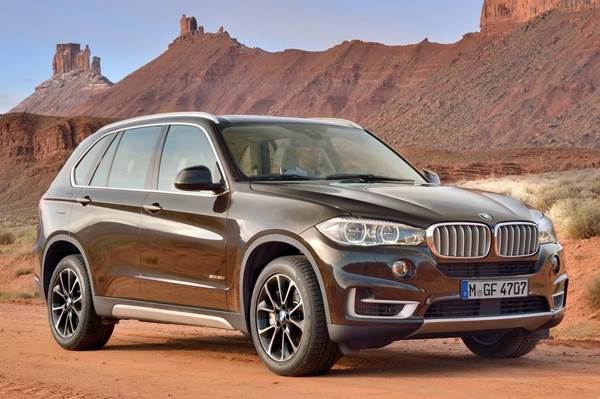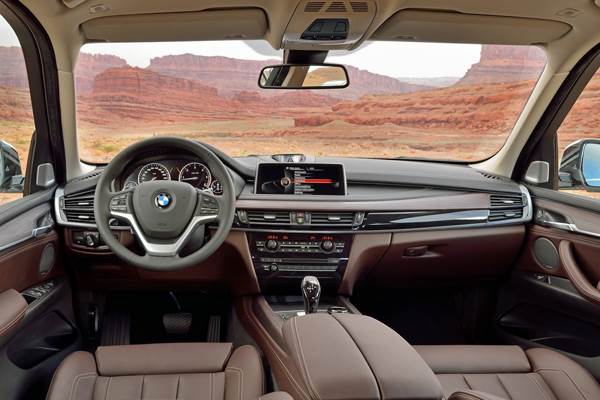The new third-generation BMW X5 will be sold with a 2.0-litre four-cylinder diesel engine in some markets and optional rear-wheel drive in a move that endows the SUV with better fuel efficiency.
The new BMW X5 has its planned public debut at the Frankfurt motor show in September.
The decision to expand the choice of engines to include a four-cylinder unit mirrors the move made by Mercedes-Benz with its latest M-class. However, BMW's decision to offer rear-wheel drive represents a first in the hotly contested luxury SUV ranks.
Developed under the internal codename F15, the new X5 has been progressed in a typically evolutionary approach that sees it retain its upright profile and traditional features such as its two-piece tailgate. Distinguishing touches include a bolder front end with a more prominent kidney grille and LED-imbued headlamps that butt up against the chrome surround of the grille.

A heavily contoured bumper, which features so-called air curtain ducts on the lower outer edges, helps channel air through the front wheel houses to an 'air blade' duct behind the front wheel arches. The design also features on the recently introduced 3-series GT.
Overall, the new SUV receives a more structured look than its predecessor, with greater contouring within the bonnet, a more pronounced shoulder line and an added feature line within the lower section of the doors to reduce visual bulk. A tall glasshouse remains a key design feature and follows on from the original E53 model launched in 1999 and the second-generation E70 model in 2008.
At 4886mm in length, 1938mm in width and 1762mm in height, the new X5 is 32mm longer, 5mm wider and 14mm taller than its predecessor. It shares its 2933mm wheelbase with the second-generation X5 but the tracks have been shortened by 4mm both front and rear to 1640mm and 1646mm, endowing it with a slightly smaller footprint.
The new BMW X5 has been given a more luxurious interior with styling that follows the lineage of recent BMW models. Buyers will get the option of two rear seat configurations: a fixed 40/20/40 split bench arrangement and a newly developed 70/30 split bench that adjusts longitudinally to free up leg space for an optional third row of seats. Boot capacity is up by 30 litres at 650 litres, rising to 1870 litres when the second and third seat rows are folded away.
The Audi Q7, Mercedes-Benz M-class and Range Rover-rivalling SUV comes with a long list of advanced optional extras. Included is a heads up display, night vision with human and animal detection, lane departure warning and road sign information, a 360deg surround-view parking assistant and collision warning with an automatic braking function. As part of an improved range of multimedia features as part of its ConnectedDrive initiative, the new X5 will also offer full internet access, in-car use of Facebook, Twitter and other on-line services as well as a dictation function with speech recognition for e-mails and text messages.
BMW’s new X5 SUV is based around a lightly modified version of the existing model’s monocoque steel platform. A series of lightweight construction initiatives, including the use of a greater percentage of hot formed high strength steel within the floorpan, has led to a reduction in weight over the old X5. In standard xDrive30d guise, BMW claims a kerb weight of 2070kg, or 80kg less than the outgoing model despite the slight increase in external dimensions and more flexible interior appointments.
The chassis is similarly a development of that used by the old model, with a combination of double wishbones up front and a multi-link arrangement at the rear. Buyers will be able to choose between four different states of chassis tune: a basic steel-sprung set-up and three optional suspension set-ups – Comfort, Dynamic and Professional – with air springs.
The latter two come with adaptive damping and also receive BMW’sDynamic Performance Control system, as seen on the X6, with a mechanically operated torque vectoring system on the rear axle for added agility. A development of the reworked chassis is earmarked for the second-generation X6 set to be revealed at the Moscow motor show in mid-2014.

Included in the global line-up is a turbocharged 4.4-litre V8 petrol unit that produces 444bhp in the xDrive50i and a turbocharged 3.0-litre in-line six-cylinder common rail diesel with 254bhp in the xDrive30d. BMW’s heavily lauded triple turbocharged 3.0-litre in-line six-cylinder common rail diesel kicks out 376bhp in the performance orientated xDrive M50d, in which it is claimed to hit 100kph in 5.3sec.
A further three engine options will be added to the line-up shortly after launch, including the first ever four-cylinder to find its way into the X5, a turbocharged 2.0-litre diesel with 215bhp. The new base engine will be available in both the four-wheel-drive xDrive25d and, in a first for the X5, rear-wheel-drive sDrive25d.
Also planned is a powered-up version of the turbocharged 3.0-litre in-line six-cylinder diesel with 309bhp in the xDrive40d, and a 302bhp turbocharged 3.0-litre in-line six-cylinder petrol engine in the xDrive35i.
BMW is yet to confirm a successor to today’s X5 M, although indications are that it will be added to the line-up in 2014 in combination with a follow-up to the existing X6 M. Both are set to receive a reworked version of the 560bhp twin-turbocharged 4.4-litre V8 used in the M5 and M6.
With a strong focus on the American, Chinese and Russian markets, BMW plans to offer the new X5 with a choice of petrol-electric or diesel-electric hybrid drive in the future. It's not likely that these, however, will be available until 2015.
The new X5 will continue to roll from BMW’s US production line in Spartanburg, South Carolina, which is now home to the X3, X6 and shortly a production version of the German car maker’s X4 Concept.
Since its introduction to the German car maker’s line-up in 1999, the X5 has racked up over 1.3 million sales worldwide.





Comments
Member Login
Personal Details
No comments yet. Be the first to comment.